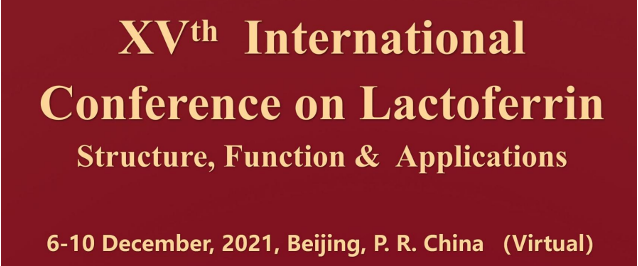15th International Conference on Structure, Function and Application of Lactoferrin
Beijing, China 2021
Duration: 3 minutes

15th International Conference on Structure, Function and Application of Lactoferrin
The 15th International Lactoferrin Conference was held in Beijing, China from 6-10 December. The conference was hosted by Jianhua Wang PhD, professor at the Feed Research Institute of the Chinese Academy of Agricultural Sciences, whose research includes the bioactivity of lactoferrin.
During the biennial conference, scientists from all over the world virtually addressed the most important topics related to the protein lactoferrin, including its biochemical properties, biological function, technological standard and clinical applications.
Lactoferrin, also known as pink protein due to its colouration in its pure form, is a natural iron-binding glycoprotein found in cow's milk and human milk. Following the discovery of the protein in 1939 by Sorensen and Sorensen and its first isolation by Groves and others in the 1960s, research on lactoferrin has intensified.1 The promising results of studies on the health-promoting effects of lactoferrin have led to its increasing use as an ingredient or additive, for example in infant nutrition products, food supplements and personal care and cosmetic products.2
About 200 participants from 28 countries attended the virtual conference, which consisted of 76 oral presentations with a total duration of about 33 hours and 12 poster presentations. Basic and clinical research by internationally active scientists was presented and the latest results, potential applications and perspectives were discussed.
With the pandemic now more than two years old, the thematic focus was on the effect of lactoferrin on covid-19. In addition to cell culture studies, the first exciting and promising results from clinical trials were presented, showing that lactoferrin can alleviate the clinical symptoms of covid-19 infection and shorten the healing time. In addition, the underlying antiviral mechanism has been elucidated, so that lactoferrin is well on its way to becoming an effective drug candidate against coronavirus.3–7
Standardisation of lactoferrin products has been widely addressed in terms of quality, biological activity and technological innovation. It was reconfirmed that purity plays a key role in application.
Other exciting topics on the programme included the many positive immunomodulatory effects, the bioavailability of lactoferrin when taken orally, and the protective effects on neonatal health development.
We at Mercurius Production were able to gain a lot of exciting information and insights that will be groundbreaking and decisive, especially in the context of future projects.